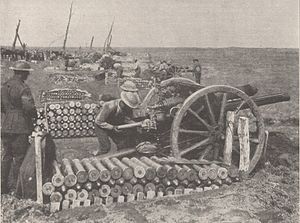| Ordnance Quick Firing 18-pounder | |
|---|---|
 Australian gun crew in action in the Ypres sector, 28 September 1917 | |
| Type | Field gun |
| Place of origin | United Kingdom |
| Service history | |
| In service | 1904–1940 |
| Used by | British Empire Russian Empire Irish Free State Finland Estonia |
| Wars | First World War[1] Third Afghan War Russian Civil War Irish Civil War Waziristan 1936–37 Continuation War |
| Production history | |
| Designer | Armstrong Whitworth Vickers Royal Arsenal |
| Designed | 1901 |
| Manufacturer | Armstrong Whitworth Woolwich Arsenal |
| Produced | 1903–1940 |
| No. built | approx. 10,469 (Mk I & II)[2] |
| Specifications | |
| Mass | 1.282 tonnes 2,825 lb (1,281 kg) |
| Barrel length | 7 ft 8 in (2.34 m)[3] |
| Width | 6 ft 3 in (1.91 m) |
| Crew | 6[note 1] |
| Shell | 84 x 295 mm R[4] |
| Shell weight | 18.5 lb (8.4 kg) projectile 23 lb (10 kg) total including case. |
| Calibre | 3.3 in (83.82 mm) |
| Recoil | 41 in (1.0 m) (Mk I – II); 26 in (0.66 m) to 48 in (1.2 m) (Mk III – V) |
| Carriage | Pole trail (Mk I & II) box trail (Mk III & IV) split trail (Mk V) |
| Elevation | -5° to +16°(Mk I & II) +30°[5] (Mk III) +37°(Mk IV & V)[6] |
| Traverse | 4.5° left and right (Mk I – IV) 25° left and right (Mk V) |
| Rate of fire | 20 rpm (max);[7] 4 rpm (sustained)[8][note 2] |
| Muzzle velocity | 1,615 ft/s (492 m/s) (Mk I & II)[3] 1,615 ft/s (492 m/s) (Mk IV)[9] |
| Effective firing range | 6,525 yd (5,966 m) Mk I & II 7,800 yd (7,100 m) with trail dug in 9,300 yd (8,500 m) (Mk III, IV & V) 11,100 yd (10,100 m) (streamlined HE Shell Mk IC) |
The Ordnance QF 18-pounder,[note 3] or simply 18-pounder gun, was the standard British Empire field gun of the First World War-era. It formed the backbone of the Royal Field Artillery during the war, and was produced in large numbers. It was used by British Forces in all the main theatres, and by British troops in Russia in 1919. Its calibre (84 mm) and shell weight were greater than those of the equivalent field guns in French (75 mm) and German (77 mm) service. It was generally horse drawn until mechanisation in the 1930s.
The first versions were introduced in 1904. Later versions remained in service with British forces until early 1942. During the interwar period, the 18-pounder was developed into the early versions of the Ordnance QF 25-pounder, which would form the basis of the British artillery forces during and after the Second World War in much the same fashion as the 18-pounder had during the First.
- ^ Smith, Colin (2006). Singapore Burning. Penguin. p. 132. ISBN 978-0-14-101036-6.
- ^ Clarke, pg. 33
- ^ a b Hogg & Thurston, pg. 81
- ^ "78- MM CALIBRE CARTRIDGES". www.quarryhs.co.uk. Retrieved 5 September 2017.
- ^ Hogg & Thurston, pg. 83
- ^ Hall December 1973
- ^ Farndale 1986, pg. 1
- ^ Farndale 1986, pg. 159. Following the experience of the Battle of the Somme the 18-pounder was limited from January 1917 to 4 rounds per minute, as the barrel and recoil mechanism could not stand more. "And this rate should only be maintained for short periods" : "Artillery in Offensive Operations", 11. Rate of Fire and Depth of Lifts.
- ^ Major D Hall, December 1973 quotes 1,640 ft/s (500 m/s)
for Mk IV. Hogg & Thurston quote 1615. Other sources quote 1625 and 1632. Maximum muzzle velocity of Mk IV was apparently fractionally higher than Mk II, and appears to have been related to usage of more modern ammunition post-WWI.
Cite error: There are <ref group=note> tags on this page, but the references will not show without a {{reflist|group=note}} template (see the help page).